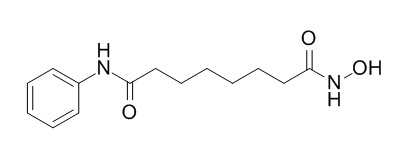Vorinostat(SAHA)
Vorinostat (suberoylanilide hydroxamic acid, SAHA, MK0683) is an HDAC inhibitor with IC50 of ~10 nM in a cell-free assay. Vorinostat abrogates productive HPV-18 DNA amplification.
Inquire / Order:
manager@chemfaces.com
Technical Inquiries:
service@chemfaces.com
Tel:
+86-27-84237783
Fax:
+86-27-84254680
Address:
1 Building, No. 83, CheCheng Rd., Wuhan Economic and Technological Development Zone, Wuhan, Hubei 430056, PRC
Providing storage is as stated on the product vial and the vial is kept tightly sealed, the product can be stored for up to
24 months(2-8C).
Wherever possible, you should prepare and use solutions on the same day. However, if you need to make up stock solutions in advance, we recommend that you store the solution as aliquots in tightly sealed vials at -20C. Generally, these will be useable for up to two weeks. Before use, and prior to opening the vial we recommend that you allow your product to equilibrate to room temperature for at least 1 hour.
Need more advice on solubility, usage and handling? Please email to: service@chemfaces.com
The packaging of the product may have turned upside down during transportation, resulting in the natural compounds adhering to the neck or cap of the vial. take the vial out of its packaging and gently shake to let the compounds fall to the bottom of the vial. for liquid products, centrifuge at 200-500 RPM to gather the liquid at the bottom of the vial. try to avoid loss or contamination during handling.
Phys Chem Chem Phys.2018, 20(23):15986-15994
Biomed Chromatogr.2019, 8:e4774
Separations2023, 10(4),255.
Nutrients.2019, 11(6):E1380
Inflammation.2024, 02034-1.
Chemistr of plant2016, 2016021195
Metab Eng.2022, 75:143-152.
J Pharm Biomed Anal.2023, 234:115570.
Int J Mol Sci.2021, 22(14):7324.
J Ethnopharmacol.2017, 197:157-164
Related and Featured Products
Cancer Res,2001 Dec 1;61(23):8492-7.
The histone deacetylase inhibitor suberoylanilide hydroxamic acid induces differentiation of human breast cancer cells[Pubmed:
11016644]
Histone deacetylase (HDACs) regulate histone acetylation by catalyzing the removal of acetyl groups on the NH(2)-terminal lysine residues of the core nucleosomal histones. Modulation of the acetylation status of core histones is involved in the regulation of the transcriptional activity of certain genes. HDAC activity is generally associated with transcriptional repression. Aberrant recruitment of HDAC activity has been associated with the development of certain human cancers.
METHODS AND RESULTS:
We have developed a class of HDAC inhibitors, such as suberoylanilide hydroxamic acid (SAHA), that were initially identified based on their ability to induce differentiation of cultured murine erythroleukemia cells. Additional studies have demonstrated that SAHA inhibits the growth of tumors in rodents. In this study we have examined the effects of SAHA on MCF-7 human breast cancer cells. We found that SAHA causes the inhibition of proliferation, accumulation of cells in a dose-dependent manner in G(1) then G(2)-M phase of the cell cycle, and induction of milk fat globule protein, milk fat membrane globule protein, and lipid droplets. Growth inhibition was associated with morphological changes including the flattening and enlargement of the cytoplasm, and a decrease in the nuclear:cytoplasmic ratio. Withdrawal of SAHA led to reentry of cells into the cell cycle and reversal to a less differentiated phenotype. SAHA induced differentiation in the estrogen receptor-negative cell line SKBr-3 and the retinoblastoma-negative cell line MDA-468.
CONCLUSIONS:
We propose that SAHA has profound antiproliferative activity by causing these cells to undergo cell cycle arrest and differentiation that is dependent on the presence of SAHA. SAHA and other HDAC inhibitors are currently in Phase I clinical trials. These findings may impact the clinical use of these drugs.
Proc Natl Acad Sci U S A, 1998 Mar 17;95(6):3003-7.
A class of hybrid polar inducers of transformed cell differentiation inhibits histone deacetylases.[Pubmed:
9501205]
The lysate of Jurkat cells is incubated for 1 hour on ice and cleared by centrifugation at 12,000 g for 10 minutes at 4 °C. Supernatants are precleared with 30 μL of 50% protein G-Sepharose slurry for 1 hour at 4 °C. Beads are pelleted by centrifugation and supernatants are incubated for 1 hour at 4 °C with 10 μg of IgG fraction from anti-HDAC1 or HDAC3 polyclonal antisera (preincubated 2 hours at room temperature with either the homologous or heterologous immunizing peptide). Both antisera are raised in rabbits against the carboxylterminal peptide of HDAC1 and HDAC3 by using synthetic peptides coupled to keyhole limpet hemocyanin. 30 μL of 50% protein G-Sepharose slurry is added for 1 hour at 4 °C. Immune complexes are pelleted by centrifugation and washed three times with 1 mL of lysis buffer. Beads are resuspended in 200 μL of HDAC buffer (20 mM Tris-HCl, pH 8.0/150 mM NaCl/10% glycerol), and the HDAC assay is performed with an 3H-acetylated peptide corresponding to amino acids 1-24 of histone H4. Released [3H]acetic acid is quantified by scintillation counting. For inhibitions studies, the immunoprecipitated complexes are preincubated with the different concentrations of Vorinostat for 30 minutes at 4 °C.
Cancer Res,2000 Sep 15;60(18):5165-70.
Suberoylanilide hydroxamic acid, an inhibitor of histone deacetylase, suppresses the growth of prostate cancer cells in vitro and in vivo.[Pubmed:
11016644]
Cell lines: LNCaP, PC-3, and TSU-Pr1
Concentrations: Dissolved in DMSO, final concentrations ~7.5 μM
Incubation Time: 1, 2, 3 and 4 days
Method:
Cells are exposed to various concentrations of Vorinostat for 1, 2, 3 and 4 days. Cell viability is assessed by trypan blue dye exclusion.



